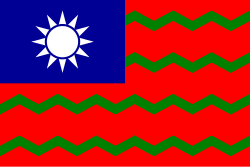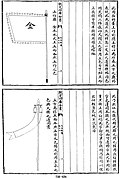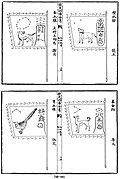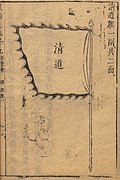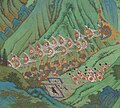List of Chinese flags
 From Wikipedia - Reading time: 31 min
From Wikipedia - Reading time: 31 min
This article needs additional citations for verification. (June 2022) |
This is a list of flags of entities named or related to "China".
People's Republic of China
[edit]National flags
[edit]| Flag | Duration | Use | Description |
|---|---|---|---|
 |
1 October 1949–present | Flag of the People's Republic of China[1] | A red field, with a large gold star with four smaller stars to the right at the canton. This flag is flown in mainland China, Hong Kong, and Macau. |
Special administrative regions flags
[edit]| Flag | Duration | Use | Description |
|---|---|---|---|
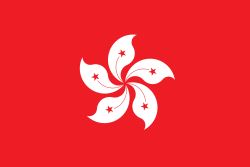 |
1 July 1997–present | Flag of Hong Kong[2] | A white, five-petal Bauhinia blakeana on a red field with 1 star on each of the petals. The Chinese name of Bauhinia × blakeana has also been frequently shortened as 紫荊/紫荆 (洋 yáng means "foreign" in Chinese, and this would be deemed inappropriate by the PRC government), although 紫荊/紫荆 refers to another genus called Cercis. A statue of the plant has been erected in Golden Bauhinia Square in Hong Kong. |
 |
20 December 1999–present | Flag of Macau[3] | A lotus flower above a stylized bridge and water in white, beneath an arc of five gold, five-pointed stars on a green field |
Military flags
[edit]| Flag | Duration | Use | Description |
|---|---|---|---|
 |
1948–present | Flag of the People's Liberation Army[4] | A red field with a yellow star at the canton, and the Chinese numerals for "8" and "1", the date of the PLA's establishment on 1 August 1927. |
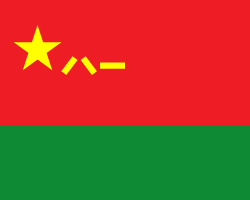 |
1992–present | Ensign of the People's Liberation Army Ground Force[4] | The PLA flag with a green stripe at the bottom, representing the ground. |
 |
1950s | Jack of the People's Liberation Army Navy[5] | The red flag with PLA emblem and a blue stripe in the center. |
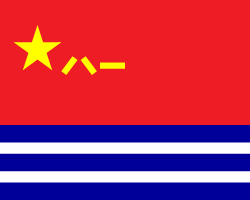 |
1992–present | Ensign of the People's Liberation Army Navy[4] | The PLA flag with 5 horizontal lines, 3 blue and 2 white at the bottom, representing the sea. |
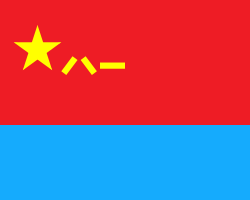 |
Ensign of the People's Liberation Army Air Force[4] | The PLA flag with a blue stripe at the bottom, representing the sky. | |
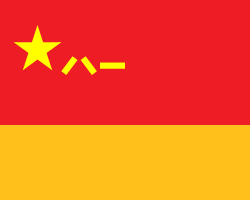 |
2016–present | Ensign of the People's Liberation Army Rocket Force[6][7] | The PLA flag with a gold yellow stripe at the bottom, representing the flare of missile launching. |
 |
2018–present | Flag of the People's Armed Police Force[8] | The PLA flag with three green bars at the bottom. |
Civil flags
[edit]| Flag | Duration | Use | Description |
|---|---|---|---|
  |
1949–present | Flag of Young Pioneers of China[9] | Red flag with yellow five-pointed star and torch in the middle. |
 |
1922–present | Flag of Communist Youth League of China[10] | Red flag with encircled yellow five-pointed star. |
 |
1950s–present | Flag of the Customs of the People's Republic of China[11] | The caduceus crossed with a golden key is added to flag of the People's Republic of China. |
 |
2018–present | Flag of the China Fire and Rescue Service[12] | Bicolor flag in red and blue with the badge of the China Fire and Rescue Service at the top and the bilingual text "Flag of China Fire and Rescue" at the bottom. |
 |
2020–present | Flag of the People's Police of the People's Republic of China[13] | Red flag with a blue stripe in the bottom and the badge of the People's Police in the canton. |
 |
?–present | Flag of the China Maritime Safety Administration | |
 |
2021–present | Flag of the National Immigration Administration of China[14] | Red flag with the organization's logo and a blue wall. |
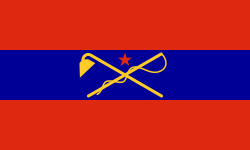 |
1945–1979[citation needed] | Flag of Inner-Mongolian Autonomous Government[15] | A red five-pointed star above a hoe and a horse pole that are crossed, symbolizing the unity of farmers and herdsmen in Inner Mongolia to for equal autonomy under the leadership of the Chinese Communist Party. |
City flags
[edit]| Flag | Duration | Use | Description |
|---|---|---|---|
 |
1997 | Flag of Ningbo[16] | |
| 1988–1997 | Flag of Nanjing[16] | ||
| 2006–present | Flag of Kaifeng[16] | ||
| 2009–present | Flag of Shangrao[16] |
Political flags
[edit]| Flag | Duration | Use | Description |
|---|---|---|---|
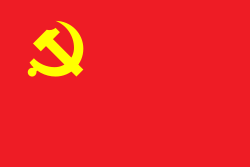 |
1996–present | Flag of the Chinese Communist Party[17] | A red flag with a golden Party emblem on it.[17] |
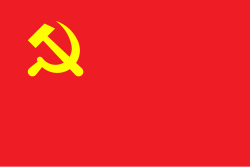 |
1921–1996 | ||
 |
1927–1964 | Flag of the Chinese Peasants' Association | Plough flag |
 |
1925–1953 | Flag of the China Party for Public Interest | Stylized "井" in canton |
Flags of Political Groups and Separatist Movements
[edit]| Flag | Duration | Use | Description |
|---|---|---|---|
 |
2008–2009 | Flag of the Maoist Communist Party of China | Red flag featuring a portrait of young Mao Zedong on the top left. |
 |
1989 | Flag of the Beijing Students' Autonomous Federation[18] | A flag created by students present during the 1989 Tiananmen Square Protests. |
 |
1997–present | Flag of the Inner Mongolian People's Party | |
 |
1959–present | Flag of the Central Tibetan Administration | Same as the previous flag of Tibet. |
 |
1933–present | The Kök Bayraq, flag of the East Turkestan independence movement | First adopted as the flag of the First East Turkestan Republic (1933–1934). Now also used by the East Turkistan Government-in-Exile. |
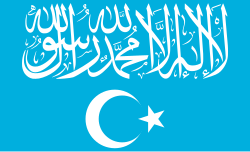 |
1988–present | Flags of the Turkistan Islamic Party |
Proposed national flags of the People's Republic of China
[edit]In July 1949, a contest was announced for a national flag for the newly founded People's Republic of China (PRC). From a total of about 3,000 proposed designs, 38 finalists were chosen. In September, the current flag, submitted by Zeng Liansong, was officially adopted, with the hammer and sickle removed.[19]
Alternative proposals
[edit]-
Zeng Liansong's original proposal for the PRC flag[20]
-
Mao Zedong's proposal for the PRC flag symbolizing the Yellow River[21]
-
Proposal 2 for the PRC flag symbolizing the Yellow River and the Yangtze River
-
Proposal 3 for the PRC flag symbolizing the Yellow River, the Yangtze River and the Pearl River
-
Proposal 4 for the PRC flag
Selection of proposals
[edit]-
Design by Ai Qing
-
Design by Bao Qiquan
-
Design by Chen Duo
-
Design by Chen Lu
-
Design by Guo Moruo
-
Design by Guo Moruo
-
Design by Hu Yuanqing
-
Design by Jiang Dazhong
-
Design by Kang Jian
-
Design by Liang Congjie
-
Design by Luo Wen
-
Design by Mo Hongshu
-
Design by Mo Zongjiang
-
Design by Pang Xunqin
-
Design by Wu Yuzhang
-
Design by Wu Yuzhang
-
Design by Xiao Shufang
-
Design by Xiao Shufang
-
Design by Xiao Shuhua
-
Design by Xiao Shuhua
-
Design by Yan Xinghua
-
Design by Yang Taiyang
-
Design by Yang Taiyang
-
Design by Yu Zhuosheng
-
Design by Zhang Ding and Zhong Ling
-
Design by Zhang Ding and Zhong Ling
-
Design by Zhang Ding and Zhong Ling
-
Design by Zhang Ding and Zhong Ling
-
Design by Zhang Ding and Zhong Ling
-
Design by Zhang Ding, Zhong Ling and Zhou Guangyuan
-
Design by Zhang Ding, Zhong Ling and Zhou Guangyuan
-
Design by Zhang Ding, Zhong Ling, Zhou Guangyuan and Xiao Shuhua
-
Design by Zhu De
House flags
[edit]| Flag | Duration | Use | Description |
|---|---|---|---|
| 1984–present | House flag of China Merchants Group[22] | ||
 |
1951–1984 | ||
 |
1960–1993 | House flag of COSCO |
Historical socialist states
[edit]| Flag | Duration | Use | Description |
|---|---|---|---|
 |
1931–34 | Flag used in the Minxi Soviet Government | A red star and black hammer and sickle on the top-left corner. |
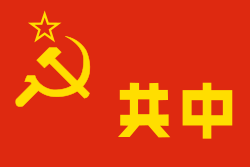 |
Jiangxi Soviet republic flag | A red star and hammer and sickle along with Chinese characters for "Chinese Communists" (Zhonggong, 中共) written in classical word order, i.e., read from the right. | |
 |
Flag of the Chinese Soviet Republic[23] | Red flag with the national emblem in the center. | |
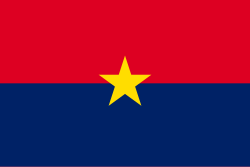 |
1933–34 | Flag of the Fujian People's Government | A horizontal bicolour of red and blue and charged with a yellow five-pointed star in the center. |
 |
1928–41 | Flag used in the Qiongya Soviet Government |
Historical military flags
[edit]| Flag | Duration | Use | Description |
|---|---|---|---|
 |
1931 | Flag of the Northeast Righteous and Brave Army[24] | Red flag with the text "東北義勇軍" and a star. |
 |
Flag of the Third Army of the Shandong People's Anti-Japanese Salvation Army[25] | ||
| 1927–1928 | Flag of the Chinese Workers' and Peasants' Red Army[5] | Same as the 1928 version, but the left side reads "工農革命軍" (China Workers'/Peasants' Revolutionary Army). Divisions were added, for example "第二軍第一師" (Second Army, 1st Division). | |
 |
1928–1930 | Flag of the Chinese Workers' and Peasants' Red Army[24] | Left side reads "中國工農紅軍" (Chinese Workers' and Peasants' Red Army). |
| 1930 | Flag of the Chinese Workers' and Peasants' Red Army | Same as the 1928 version, but the left side has no characters and the top reads "全世界無產階級聯合起來" ("Proletariats of the world, unite!"). | |
 |
1930–1931 | Flag of the Chinese Workers' and Peasants' Red Army[5] | Same as April 1930 version but top reads "全世界無產階級及被壓迫民族聯合起來" ("Proletariats and oppressed peoples of the world, unite!"). |
 |
1931–1934 | Flag of the Chinese Workers' and Peasants' Red Army[5] | Same as 1934 version but with blank white left side and colored fringe around the edges (6 variants – red for infantry, yellow for cavalry, black for artillery, white for engineering, blue for logistics, green for medical). |
 |
1934–1937 | Flag of the Chinese Workers' and Peasants' Red Army[23] | |
 |
1937–1947 | Flag of the Eighth Route Army (18th Group Army)[24] in use by communist forces in the Second United Front during the Second Sino Japanese War | National Revolutionary Army unit flag with text "國民革命軍第十八集團軍" (National Revolutionary Army 18th Group Army) on the side. |
Republic of China
[edit]National flags
[edit]| Flag | Duration | Use | Description |
|---|---|---|---|
 |
9 December 1928–present | Flag of the Republic of China[26] | Commonly known as "Taiwan". A red field, with a blue canton containing a 12-ray white sun. This flag flew over mainland China until 1949, and is presently flown on the island of Taiwan and other islands under the control of the ROC. |
 |
1950–present | Flag of the Republic of China (vertical) | Vertical red banner; in the canton, a Blue Sky with a White Sun pointing upward on a blue field. |
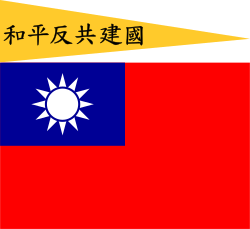 |
1940–1943 | Flag of the Reorganized National Government of the Republic of China. | Used by the Japanese puppet rebel government until 1943 when the pennant was removed and the regular ROC flag took its place. The pennant reads "Peace, Anti-Communism, National Construction". |
 |
Used by the Japanese puppet rebel government until 1943 when the pennant was removed and the regular ROC flag took its place. The pennant reads "Peace, Anti-Communism". | ||
 |
Used by the Japanese puppet rebel government until 1943 when the pennant was removed and the regular ROC flag took its place. The pennant reads "Peace, National Construction". | ||
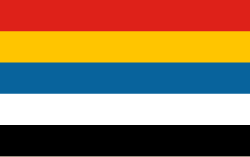 |
1912–1928 | First flag of the Republic of China, or "Five-colored flag" | It was widely flown even before the Republic of China in Shanghai and eastern parts of north China until 1928. The stripe representation: red for Han Chinese, yellow for Manchus, blue for Mongols, white for Hui and black for Tibetans. Later used by the Japanese puppet states of the East Hebei Autonomous Government, the Chinese Provisional Government, and the Reformed Government. |
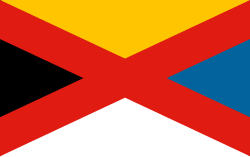 |
1916 | Flag of Empire of China. | The version with the red saltire was more commonly used than the version with the red centered cross. |
 |
1916 | Variant flag of Empire of China. |
Regional government flags
[edit]| Flag | Duration | Use | Description |
|---|---|---|---|
 |
1911–1912 | Flag of the Great Han Sichuan Military Government.[27] | |
 |
Bagua flag of the Shanxi Provincial Military Governmentzh |
Standards
[edit]Head of state
[edit]| Flag | Duration | Use | Description |
|---|---|---|---|

|
1988–present | Standard of the president of the Republic of China | |

|
1929–1988 | Old standard of the president of the Republic of China | |
 |
1927–1928 | Commander-in-chief flag of the Republic of China (Beiyang government) |
Vice president
[edit]| Flag | Duration | Use | Description |
|---|---|---|---|
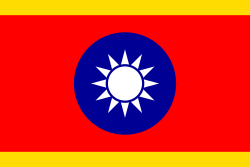 |
1947–1986 | Standard of the Vice President of the Republic of China | Abolished with the Act of Ensign of the Republic of China Navy (海軍旗章條例) on 3 January 1986. |
Other high executive officials
[edit]| Flag | Duration | Use | Description |
|---|---|---|---|
 |
1929–2003 | A common flag for all ROC high executive officials |
Military flags
[edit]| Flag | Duration | Use | Description |
|---|---|---|---|
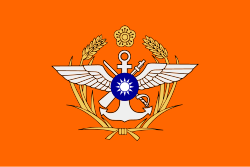 |
1986–present | Flag of the Ministry of National Defense of the Republic of China (Republic of China Armed Forces)[28] | |

|
Flag of the Chief of the General Staff (Republic of China Armed Forces)[28] | ||
 |
1924–present | Flag of the Republic of China Military Police | |
 |
1945–present | Flag of the Republic of China Armed Forces Reserve[28] | |
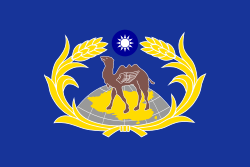 |
1946–2012 | Flag of the Republic of China Joint Logistics Command | |
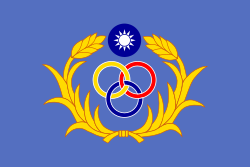 |
1945–1992 | Flag of the Taiwan Garrison Command |
Army
[edit]| Flag | Duration | Use | Description |
|---|---|---|---|

|
1924–present | Flag of the Republic of China Army (formerly National Revolutionary Army) | The Blue Sky with a White Sun with a red border. |

|
Flag of the Army commander | ||

|
Senior General's Flag | ||
 |
General's Flag | ||
 |
Lieutenant General's Flag | ||

|
Major General's Flag | ||

|
Colonel's Flag | ||
  |
1911–1928 | Flag of the Wuchang uprising; army flag of the Republic of China | The banner of the Wuchang uprising of 10 October 1911, subsequently used as the flag of the army of the Republic of China, c. 1913–28. |
Navy
[edit]| Flag | Duration | Use | Description |
|---|---|---|---|
 |
1912–present | Ensign of the Republic of China Navy | |
 |
1942–1945 | Ensign of the Reorganized National Government of the Republic of China. | Used by the Japanese puppet government from 1 May 1942 until the end of the regime. |
 |
1911 | First Naval Ensign of the Republic of China | |
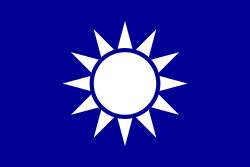 |
1928–present | Naval jack of the Republic of China Navy | Identical to the Kuomintang flag (see below). |
 |
1940–1945 | Naval jack of Reorganized National Government of the Republic of China | Used by the Japanese puppet government from 1940 until the end of the regime. The pennant reads "Kuomintang". |
 |
1912–1928 | Naval jack of the Republic of China Navy | |
Rank flags
| |||
 |
Commanding General of Navy Flag | ||
 |
1912– | Senior Admiral's Flag | |
 |
Admiral's Flag | ||
 |
Vice Admiral's Flag | ||
 |
Rear Admiral's Flag | ||
 |
Captain's Flag | ||
 |
1912– | Flag of the Bordered Blue Banner of the Eight Banners | |
 |
1924– | Battle Fleet Leader's Pennant | |
 |
1962– | Navigating Battle Ship Pennant | |
| 1924– | Commission Pennant | ||
 |
1912– | Duty Pennant | |
 |
1986– | ROCN Unit Flag | |
Air Force
[edit]Marine Corps
[edit]Combined Logistics Command
[edit]| Flag | Duration | Use | Description |
|---|---|---|---|
 |
1973–2012 | Flag of the Republic of China Combined Service Force | |
 |
1964–1979 | ||
 |
1960–1964 | ||
 |
1958–1960 | ||
 |
1956–1958 | ||
 |
1952–1956 |
National Defense University
[edit]| Flag | Duration | Use | Description |
|---|---|---|---|
 |
2014–present | Banner of the Military College of the National Defense University | |
 |
The banner of the Military College of Command and Staff of the National Defense University | ||
 |
Naval Command and Staff College Flag | ||
 |
Air Command and Staff College Flag | ||
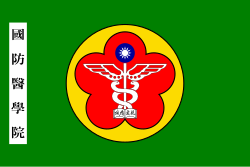 |
National Defense Medical Center Flag | ||
 |
Flag of Fu Hsing Kang College | ||
 |
Chung Cheng Institute of Technology Flag | ||
 |
Flag of the Higher School of Management of the National Defense University | ||
 |
2000–2014 | Old banner of the Military College of the National Defense University | |
 |
1968–2000 | Old flag of the National Defense University |
Coast Guard Administration
[edit]Police
[edit]| Flag | Duration | Use | Description |
|---|---|---|---|

|
1974–present | Flag of police of the Republic of China | |
 |
1947–1974 | Flag of police of the Republic of China | Flag of the Republic of China defaced with the golden pigeon in the fly. |
 |
1932–1947 | Flag of police of the Republic of China. | |

|
1912–1928 | Flag of police of the Republic of China | |

|
1974–present | Flag of National Police Agency | |
 |
Flag of Central Police University | ||
 |
Flag of Volunteer Police of the Republic of China | ||
 |
Flag of Director-General of ROC Police | ||
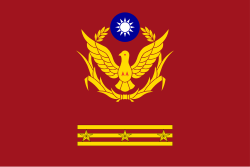 |
Flag of Commissioner of Direct-controlled municipality of ROC Police | ||

|
1932–1949 | Flag of Voluntary Police of the Republic of China |
Water Police
[edit]| Flag | Duration | Use | Description |
|---|---|---|---|

|
1928–1949 | Ensign of the Chinese Water Police | |

|
1912–1928 |
Fire Service
[edit]| Flag | Duration | Use | Description |
|---|---|---|---|
 |
1996–present | Flag of fire service of the Republic of China | |
 |
Unit Flag of Fire Service |
Rescue aviation
[edit]| Flag | Duration | Use | Description |
|---|---|---|---|
 |
2005–present | Flag of the National Airborne Service Corps |
Ministries
[edit]| Flag | Duration | Use | Description |
|---|---|---|---|
 |
Flag of the Sports Administration | ||
 |
Flag of the Ministry of Transportation and Communications | ||
 |
Flag of the Ministry of Education | ||
 |
2014–present | Flag of the Ministry of Finance | |
 |
1950–2014 | Previously used as flag of the Inspector-General of Customs during 1929–50. Green background with yellow saltire superimposed by "Blue Sky with a White Sun" flag. | |
 |
Flag of the Ministry of Health and Welfare |
Councils
[edit]| Flag | Duration | Use | Description |
|---|---|---|---|
| Flag of the Atomic Energy Council | |||
 |
Flag of the Veterans Affairs Council | ||
 |
Flag of the Overseas Community Affairs Council | ||
 |
Flag of the National Communications Commission | ||
| Flag of the National Development Council |
Agency
[edit]| Flag | Duration | Use | Description |
|---|---|---|---|
 |
Flag of Taiwan Area National Freeway Bureau of the Republic of China | Not in use since Taiwan Area National Bureau merged into Freeway Bureau in 2018. | |
 |
Flag of Civil Aeronautics Administration of the Republic of China | ||
 |
Flag of Bureau of High Speed Rail of the Republic of China | Not in use since Bureau of High Speed Rail merged into Railway Bureau in 2018. | |
 |
Flag of Taiwan Area National Expressway Engineering Bureau, MOTC, Republic of China | Not in use since Taiwan Area National Expressway Engineering Bureau merged into Freeway Bureau in 2018. | |
 |
Flag of Institute of Transportation of the Republic of China | ||
 |
2014–present | Flag of Maritime and Port Bureau of the Republic of China | |
 |
2007–present | Flag of National Immigration Agency of the Republic of China |
Civil and Merchant Ensign
[edit]| Flag | Duration | Use | Description |
|---|---|---|---|
 |
1929–1966 | Civil Ensign of the Republic of China | Four serrated yellow stripes are added to the flag of the Republic of China for use as a civil ensign at sea. Present civil ensign is national flag. |
 |
1935 – around 1949 | Ensign of Chinese Fishery Patrol & Fishery Investigation Test Vessels |
Postal flags
[edit]| Flag | Duration | Use | Description |
|---|---|---|---|
 |
1935– | Postal Ensign of the Republic of China | |
 |
1929–1935 | The "Blue Sky with a White Sun" was placed in the canton. | |
 |
1919–1929 | White flag with the Five-colored flag in the canton, bilingual text "Postes" in the lower hoist quarter, and a greylag goose in the fly half. |
Chinese Maritime Customs Service
[edit]Salt Administration
[edit]| Flag | Duration | Use | Description |
|---|---|---|---|

|
1929–1949 | Ensign of the Chinese Salt Administration | |

|
1912–1929 |
Yacht Club Ensign
[edit]Sporting flags
[edit]| Flag | Duration | Use | Description |
|---|---|---|---|
 |
1979– | Chinese Taipei Olympic flag | The ROC is recognized as "Chinese Taipei" in the Olympics, due to the political status of Taiwan. |
 |
2019– | Flag of Chinese Taipei used in the Paralympic Games | |
 |
Flag of Chinese Taipei used in the Deaflympics | ||
 |
Flag of Chinese Taipei used in the Universiade | ||
 |
Chinese Taipei volleyball flag | ||
 |
Chinese Taipei esports flag | Used in esports competitions organized by Blizzard Entertainment. | |
 |
2004–2019 | Chinese Taipei Paralympic Flag | |
 |
pre-2004 | Chinese Taipei Paralympic Flag | |
 |
Former Chinese Taipei Football Flag |
City and county flags
[edit]As of November 1997, 18, the Chinese Government banned localities from making and using local flags and emblems.[29] Despite the ban, some cities have adopted their own flag that often includes their local emblem as shown below. The ROC-controlled areas continues to use the respective flags.
Provinces
[edit]The PRC-controlled mainland does not have provincial flags, but the ROC-controlled area has a flag for one of its two provinces.
| Flag | Duration | Use | Description |
|---|---|---|---|
 |
Taiwan Province |
| Flag | Administrative division | Adopted | Description | |
|---|---|---|---|---|
 |
 |
Kaohsiung City | 2010–present | Stylized "高". The colors symbolize sunshine, vitality, environmental protection, and the ocean.[30] |
 |
 |
New Taipei City | Stylized "北" in the form of four hearts arranged to resemble a four-leaf clover. | |
 |
 |
Taichung City | 2008–present | |
 |
 |
Tainan City | 2010–present | |
 |
 |
Taipei City | ||
 |
 |
Taoyuan City | 2014–present | |
 |
 |
Chiayi City | ||
 |
 |
Keelung City | ||
 |
 |
Changhua County | ||
 |
 |
Chiayi County | ||
 |
 |
Hsinchu County | ||
 |
 |
Hualien County | ||
 |
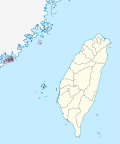 |
Kinmen County | ||
 |
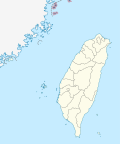 |
Lienchiang County | ||
 |
 |
Miaoli County | ||
 |
 |
Nantou County | ||
 |
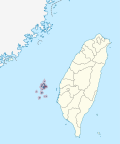 |
Penghu County | ||
 |
 |
Pingtung County | ||
 |
 |
Taitung County | ||
 |
 |
Yilan County | ||
 |
 |
Yunlin County | ||
History
[edit]| Flag | Duration | Use | Description |
|---|---|---|---|
 |
1922–1949 | Flag of Kunming[31] | The flag features the former city emblem which consists of two intersecting red circles which represent the harmony of sun and moon, as well as western and eastern ideas. In the middle is a golden stylized symbol of a 市 character. |
 |
1981–2010 | Old flag of Taipei City | Previous flag used by Taipei City, with its seal on top of 16 horizontal stripes of white and blue. |
 |
1999–2006 | Old flag of New Taipei City | |
 |
1980s–1999 | ||
 |
2006–2010 | ||
 |
?–2010 | Old flag of Hsinchu County | |
| 2018–2019 | |||
 |
2010–2018 | ||
 |
1951–2010 | Old flag of Taichung County | |
 |
1978–2010 | Old flag of Tainan City | |
 |
?–2010 | Old flag of Tainan County | |
 |
1974–2009 | Old flag of Kaohsiung City | |
 |
?–1999 | Old flag of Kaohsiung County | |
 |
1999–2010 | Old flag of Kaohsiung County | |
 |
1984–2014 | Old flag of Taitung County |
University flags
[edit]| Flag | Duration | Use | Description |
|---|---|---|---|
 |
1910s-? | Flag of the University of China | |
 |
1928–? | Flag of the Shanghai Jiao Tong University |
Political flags
[edit]| Flag | Duration | Use | Description |
|---|---|---|---|
current
| |||
| Link to file | 2017–present | Flag of Taiwan People's Communist Party | |
 |
2007–present | Flag of Taiwan Civil Governmentzh | |
 |
2006–present | Flag of Hakka Party | |
 |
Flag of Sovereign State for Formosa & Pescadores Partyzh | ||
| Link to file | 2005–present | Flag of Taiwan Independent Unionzh | |
| Link to file | 2004–present | Flag of Non-Partisan Solidarity Union | |
 |
2003–present | Flag of Taiwan Labor Partyzh[32] | |
 |
2000–present | Flag of People First Party | |
 |
1993–present | Flag of New Party | |
 |
2010s–present | Flag of the Patriot Alliance Association | |
| 1993–present | |||
 |
1989–present | Flag of Labor Party | Red flag with green pile reversed and yellow star |
| Link to file | Flag of Chinese People's Party | ||
| Link to file | 1986–present | Flag of Democratic Progressive Party | |
 |
?–present | Flag of Democratic Progressive Party ward on the Matsu Islands | |
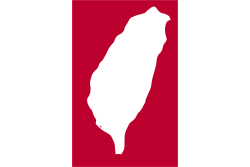 |
1970–present | Flag of World United Formosans for Independence | |
 |
1923–present | Flag of Chinese Youth Party | |
 |
1921–1949 | Flag of the Chinese Communist Party | Communist hammer and sickle. Used by the CPC during the Republic of China era. |
 |
1895–present | Flag of Kuomintang | Blue Sky with a White Sun |
former
| |||
 |
2018–2020 | Flag of Congress Party Alliance | |
 |
2014–2020 | Flag of Alliance of military personnel, officials and teacherszh | |
 |
2007–2019 | Flag of Home Party | |
 |
2018–2019 | Flag of the Taiwan Military (Junta) Government, a self-declared government led by Gao Anguo.zh | |
 |
2015–2019 | Flag of Minkuotang | |
 |
2009–2020 | Flag of Taiwan Democratic Communist Party | |
| Link to file | 2007–2019 | Flag of Taiwan Farmers' Party | |
| Link to file | 1996–2020 | Flag of Taiwan Independence Party | |
| Link to file | 1994–2020 | Flag of Taiwan Communist Party | |
 |
1991–2020 | Flag of Chinese Social Democratic Partyzh | |
 |
1946–2020 | China Democratic Socialist Party flag | Stylized "井" in center |
 |
1933–1934 | Flag of the Productive People's Party | |
 |
1929–1931 | Flag of Taiwanese People's Party (Active in Japanese Taiwan) | |
 |
1929 | Influences: | |
 |
1925–? | Flag of Guangdong Peasants' Association | Chinese national flag charged with yellow plough in fly. |
 |
1925–1946 | Flag of the Inner Mongolian People's Revolutionary Party | |
 |
1911–? | Flag of the Royalist Party | National flag (1889–1912) |
 |
19th–20th century | Flag of the Yellow Sand Society | Solid yellow flag |
Cultural flags
[edit]| Flag | Duration | Use | Description |
|---|---|---|---|
 |
2018–present | Flag of Tao people | A white flag with the traditional "boat's eye" symbol and traditional triangular ornaments on the top and bottom.[33] |
| 2017–present | Flag of Rukai people | The "Lily Flag" composed of three colors: red, yellow and green, representing hope, love and peace. The lilies and eagle feathers represent the purity and fairness of the Rukai tribe, was designed by Jin Shaohua.[34] | |
 |
2017–present | Flag of Taiwanese indigenous peoples in Taichung | |
 |
2016–present | "National flag" of Amis people in the Amis Music Festival.[35][36] | |
 |
?–present | Flag of Amis people in Taidong (Falangaw tribezh) | |
 |
1984–1998 | Flag of Taiwan Association for the Promotion of Aboriginal Rightszh |
Proposed flags
[edit]Republic of China
[edit]| Flag | Duration | Use | Description |
|---|---|---|---|
 |
1906 | Teo Eng Hock and his wife's proposal 1 for the ROC flag | |
 |
Proposal 2 for the ROC flag | ||
 |
Proposal 3 for the ROC flag, later adopted as the flag of the Republic of China Army | ||
 |
Proposal 4 for the ROC flag, later adopted as the flag of the China Zhi Gong Party | ||
 |
Proposal 5 for the ROC flag, later used as the flag of the marshall in Beiyang government |
Taiwan Independence Movement
[edit]| Flag | Duration | Use | Description |
|---|---|---|---|
 |
1955 | Republic of Taiwan Provisional Government Proposal | |
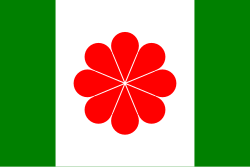 |
1994 | Donald Liu's Proposal | |
 |
2005 | 908 Taiwan Republic Campaign's Proposal | |
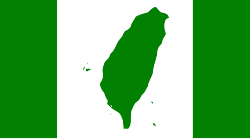 |
2013 | World Taiwanese Congress Proposal | |
 |
2016 | "Taiwan the Formosa" by Chih-Hao Chen |
Railway flags
[edit]| Flag | Duration | Use | Description |
|---|---|---|---|
 |
Railways Ensign of the Republic of China | Also the flag of the Taiwan Railways Administration. | |
 |
1919–1951 | Railways Ensign of China | Used in Taiwan from 1947 to 1951. |
House flags
[edit]| Flag | Duration | Use | Description |
|---|---|---|---|
 |
1942–1972 | House flag of China Merchants Group[37] | |
 |
1873–1942 |
Association flags
[edit]| Flag | Duration | Use | Description |
|---|---|---|---|
 |
1938–1947 | Flag of Three Principles of the People Youth League | |
 |
1952–present | Flag of China Youth Corps[38] | |
 |
1937–present | Flag of Red Swastika Society | |
 |
Flag of China Sailor's Union |
Warlords
[edit]| Flag | Duration | Use | Description |
|---|---|---|---|
 |
1933–1944 | Flag of Xinjiang | Used by Sheng Shicai's provincial government in Xinjiang until 1944. |
 |
1929 | Flag used by Zhang Xueliang's troops | Captured by Soviet soldiers in 1929. |
 |
1911 | Flag used by the rebel force in Xinhai Revolution in Anqing | |
 |
1911 | Flag used by the rebel force in Xinhai Revolution in Changsha | |
 |
1911 | Flag used by the army led by Chen Jiongming | |
 |
1911 | Flag used by the rebel force in Xinhai Revolution in Zhejiang | |
 |
1911 | Flag after the victory of the Kunming uprising | |
 |
1911 | Flag used by the Qing royalist force in Xinhai Revolution in Gejiu |
Qing dynasty and other pre-1912 states
[edit]National flags
[edit]| Flag | Duration | Use | Description |
|---|---|---|---|
 |
1862–1912 | Flag of the Qing dynasty | Naval flag and quasi-national flag on international occasions. |

|
1862–1890 | Used on Qing dynasty naval ships for identification | Triangular variant of national flag. |
Standards
[edit]| Flag | Duration | Use | Description |
|---|---|---|---|

|
1862–1912 | Standard of the Qing Emperor | Azure Dragon on a plain right triangle yellow field with the red sun of the three-legged crow in the upper left corner. |
Military flags
[edit]| Flag | Duration | Use | Description |
|---|---|---|---|

|
1644–1912 | Flag of the Green Standard Army | Flag of the Green Standard Army. A green recolouring of the Imperial Standard of the Qing Emperor. |

|
1615–1911 | Flag of the Bordered Yellow Banner of the Eight Banners | The Eight Banners was created in the early 17th century by Nurhaci to unify the Jurchen people into the Manchu dynasty. The first three banners were under the direct command of the Emperor himself. |
 |
Flag of the Plain Yellow Banner of the Eight Banners | ||
 |
Flag of the Plain White Banner of the Eight Banners | ||
 |
Flag of the Plain Red Banner of the Eight Banners | ||
 |
Flag of the Bordered White Banner of the Eight Banners | ||
 |
Flag of the Bordered Red Banner of the Eight Banners | ||
 |
Flag of the Plain Blue Banner of the Eight Banners | ||
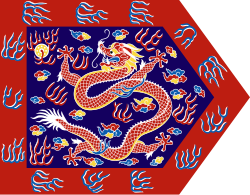 |
Flag of the Bordered Blue Banner of the Eight Banners |
Navy
[edit]| Flag | Duration | Use | Description |
|---|---|---|---|
 |
1890–1912 | The flag of the Qing Imperial Chinese Navy | Square version of above flag |
 |
1862–1890 | Used on Qing dynasty naval ships for identification | Same as national flag |
 |
1909–1911 | Flag for the Imperial Chinese Navy Secretary.[39] | |
 |
The flag of the Admiral of the Beiyang Fleet from 1909 to 1911.[39] | ||
 |
Command flag for Imperial Chinese Navy Vice Admiral.[39] | ||
 |
Command flag for Imperial Chinese Navy Rear Admiral.[39] | ||
 |
Command flag for Imperial Chinese Navy Commodore.[39] | ||
 |
Command flag for Imperial Chinese Navy Senior Officer's/Fleet Leader.[39] | ||
 |
Imperial Chinese Navy Duty Ship Pennant.[39] | ||
| Imperial Chinese Navy Commission Pennant.[39] | |||
 |
1890–1909 | The flag of the Admiral of the Beiyang Fleet from 1890 to 1909. | |
 |
1874–1890 | The flag of the Admiral of the Beiyang Fleet from 1874 to 1890. | |
 |
1890–1909 | Flag of the Commander (Tongling) of Torpedo Boats | |
 |
1905–1909 | Flag of Provincial Commander-in-Chief of Beiyang Fleet | |
 |
1890–1909 | Flag of Commodore of Beiyang Fleet | |
 |
1905–1909 | Flag of High-ranking Official of Beiyang Fleet | |
 |
Officer (Junguan) of the Beiyang Fleet | ||
 |
Flag of Minister of the Navy, or Admiral (de jure, probably not used) | ||
 |
Flag of the Admiral and Fleet Commander, or Vice Admiral (de jure, probably not used) | ||
 |
Flag of the Admiral and Squadron Commander, or Rear Admiral (de jure, probably not used) | ||
 |
Flag of the Commodore, or Commodore First Class (de jure, probably not used) | ||
 |
1890–1909 | Flag of the Leader (Duizhang), or Commodore Second Class | |
Proposed
| |||
 |
Proposed in 1863 | Ensign of Qing Navy | |
| Proposed in 1863 Commission Pennant of Qing Navy | |||
Other
| |||
 |
Junk pennants | In addition to the typical flags, some Qing ships also used individual silk pennants. | The two pictures provided here are examples only. |
Chinese Maritime Customs Service
[edit]| Flag | Duration | Use | Description |
|---|---|---|---|

|
1867–1911 | Ensign of Chinese Customs | A green flag with yellow saltire. |
House flags
[edit]| Flag | Duration | Use | Description |
|---|---|---|---|
 |
1873–1942 | House flag of China Merchants Group |
Flags of localized regimes
[edit]| Flag | Duration | Use | Description |
|---|---|---|---|
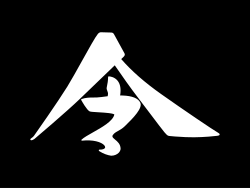
|
1860s–1885 | Flag of the Black Flag Army | Flag of the Black Flag Army, a Chinese-Vietnamese army and guerrilla force that fought against the French in the Sino-French War. A black flag with a white 令 character. |
 |
1895 | Flag of the Republic of Formosa[40] | Tiger on a plain blue filed with azure clouds below it. |
 |
1883 | Flag used by gold miners in so-called Zheltuga Republic | Flag of the Zheltuga Republic as seen on the photograph and as written in the description ("black and yellow" flag "symbolizing the union of land and gold". |
 |
1873–1877 | Flag of Yettishar | Used by Yettishar until 1877. |
 |
1865–1873 | Used by Yettishar until 1873. | |
 |
1856–1873 | Flag of Pingnan Guo | |
 |
1661–1683 | Flag of the Kingdom of Tungning | The Chinese character "鄭" in a red circle outline on a plain white field. |
 |
1624–1668 | Flag of the Dutch Formosa | Flag of the Dutch East India Company |
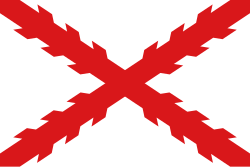 |
1626–1642 | Flag of the Spanish Formosa | Cross of Burgundy |
Flags of the Boxer Rebellion
[edit]| Flag | Duration | Use | Description |
|---|---|---|---|

|
c. 1890s–1901 | Battle flag | Battle flag used by the Yihetuan during the Boxer Rebellion. A red flag with a black square, inscribed with a red character 令 (pinyin: lìng; lit. 'command' or 'order'), inspired by the flag of the Black Flag Army. |

|
c. 1890s–1901 | Anti-foreign flag | A type of flag used by the Yihetuan during the Boxer Rebellion, inscribed with the characters 扶清滅洋 (pinyin: fú qīng miè yáng; lit. 'Support the Qing and Destroy the Foreigners'). A contemporary French Jesuit's diary describes the flag as "yellow [...] with a black border."[41] |
Flags of the Chinese Pirates
[edit]| Flag | Duration | Use | Description |
|---|---|---|---|
 |
c. 1849 | Reputedly the flag of the Chinese pirate Shap-ng-tsai or decoration confused with the ensign. | The flag is painted with a depiction of Zhang Daoling (34–156 AD), founder of Daoism as a religion in China. He is seated on a rock holding a Bagua (a symbol of Daoism) with a tiger or qilin behind him. A border of bats runs down the fly edge (a symbol of good luck).[42] |
Banners described by Wujing Zongyao
[edit]Banners described by Jixiao Xinshu
[edit]Banners described by Wubei Zhi
[edit]Banners present in old paintings
[edit]Manchukuo
[edit]National flag
[edit]| Flag | Duration | Use | Description |
|---|---|---|---|
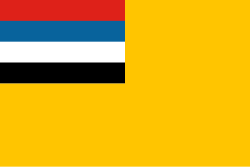 |
1932–1945 | Flag of Manchukuo | A yellow field with the red, blue, white, and black stripes of the first flag of the Republic of China (see above) in the canton. |
Standards
[edit]| Flag | Duration | Use | Description |
|---|---|---|---|
 |
1935–1945 | Imperial standard of the Emperor of Manchukuo. | Used by the Emperor of Manchukuo. |
Manchukuo Imperial Army and Navy
[edit]| Flag | Duration | Use | Description |
|---|---|---|---|
 |
1935–1945 | War ensign of Manchukuo. | Used by the Manchukuo Imperial Army. |
 |
Flag of Navy Minister of Manchukuo | ||

|
1932–1935 | Flag of admiral of the Navy | |

|
1935–1945 | Flag of admiral of the Navy | |

|
1932–1935 | Flag of vice admiral of the Navy | |

|
1935–1945 | Flag of vice admiral of the Navy | |

|
1932–1935 | Flag of rear admiral of the Navy | |

|
1935–1945 | Flag of rear admiral of the Navy | |

|
1932–1935 | Flag of 1st class commodore of the Navy | |

|
1935–1945 | Flag of 1st class commodore of the Navy | |
 |
Flag of commander (2nd class commodore) of the Navy | ||
 |
Flag of superior commander of the Navy |
Government flags
[edit]Police flags
[edit]Political flags
[edit]| Flag | Duration | Use | Description |
|---|---|---|---|
 |
1931–1945 | Flag of the Concordia Association. | Used by the Concordia Association of Manchukuo. Contains the Chinese characters 協和. |
 |
1931–1943 | Flag of the Russian Fascist Party. | Minor Russian émigré movement that was based in Manchukuo. |
Other
[edit]| Flag | Duration | Use | Description |
|---|---|---|---|
 |
1932–1945 | Flag of the Manchukuo Post | Postal flag of Manchukuo. |
 |
Flag of the Boy Scouts of Manchukuo. | Used by the Boy Scouts of Manchukuo. | |
 |
1906–1945 | Flag of the South Manchuria Railway. |
Other Japanese puppet states
[edit]| Flag | Duration | Use | Description |
|---|---|---|---|
 |
1937–1938 | Flag of the Great Way Government. | |
 |
1943 | Flag of the New People's Society. | New People's Society (新民會, "Xinminhui"), a collaborationist, quasi-political-party organization in northern China under Japanese occupation. |
 |
1938–1940 | Flag of the Reformed Government of the Republic of China. | |
 |
1936–1939 | Flag of the Mongol Military Government, which became the Flag of the Mongol United Autonomous Government in 1937. | A vertical pattern of red, yellow, white as a canton on a blue field. |
 |
1937 | Flag of the Mongol United Autonomous Government (alternate reconstruction). | Reconstruction of the flag of the Mongol United Autonomous Government based on The Airpost Journal's description. It mentions "a square of horizontal red, yellow, white and black stripes".[43] |
 |
1938–1939 | Flag of the South Chahar Autonomous Government, also known as Chanan. Later merged with the Mongol United Autonomous Government and Jinbei to create Mengjiang | A vertical pattern of red, white, blue as a canton on a yellow field. |
 |
Flag of the North Shanxi Autonomous Government, also known as Jinbei. Later merged with the Mongol United Autonomous Government and Chanan to create Mengjiang | A vertical pattern of red, blue, white as a canton on a yellow field. | |
 |
1939–1945 | Flag of Mengjiang | A horizontal pattern of yellow, blue, white, red, white, blue, and yellow again. |
Foreign concessions and colonies
[edit]Dalian
[edit]| Flag | Duration | Use | Description |
|---|---|---|---|
 |
1905–1945 | Kwantung Leased Territory | Flag of Japan |
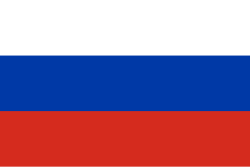 |
1898–1905 | Russian Dalian | Flag of Russia |
Tianjin
[edit]| Flag | Duration | Use | Description |
|---|---|---|---|
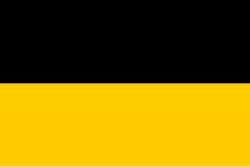 |
1901–1917 | Austro-Hungarian concession of Tianjin | Flag of the Habsburg Monarchy |
 |
1902–1931 | Belgian concession of Tianjin | Flag of Belgium |
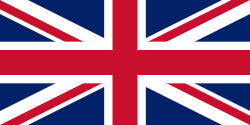 |
1860–1943 | British concession of Tianjin | Union Jack |
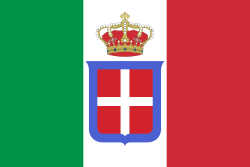 |
1901–1943 | Italian concession of Tianjin | Flag of Italy |
 |
1900–1924 | Russian concession of Tianjin | Flag of Russia |
Chinese Eastern Railway
[edit]Hong Kong
[edit]Macau
[edit]Qingdao
[edit]| Flag | Duration | Use | Description |
|---|---|---|---|
 |
1898–1914 | Kiautschou Bay Leased Territory | Flag of Germany (1867–1918) |
Shanghai
[edit]| Flag | Duration | Use | Description |
|---|---|---|---|
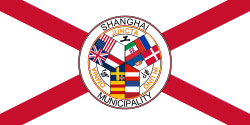 |
c. 1917–1941 | Shanghai International Settlement | |
 |
1863–c. 1917 | ||
 |
1849–1943 | Shanghai French Concession | Flag of France |
 |
1845–1863 | British Concession in Shanghai | Union Jack |
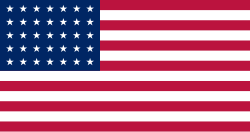 |
1848–1863 | American Concession in Shanghai | Flag of the United States |
Weihai
[edit]| Flag | Duration | Use | Description |
|---|---|---|---|
 |
1903–1930 | British Weihaiwei | A British Blue Ensign with two Mandarin ducks standing on a beach. Flag of Weihaiwei |
 |
1899–1903 | Flag of the Commissioner of Weihaiwei | |
 |
1903–1930 |
Zhanjiang
[edit]| Flag | Duration | Use | Description |
|---|---|---|---|
 |
1898–1945 | Guangzhouwan | Flag of France |
Secessionist states
[edit]East Turkestan
[edit]| Flag | Duration | Use | Description |
|---|---|---|---|
 |
1933–1934 | Flag of the First East Turkestan Republic |
Tibet
[edit]| Flag | Duration | Use | Description |
|---|---|---|---|
 |
1958–1974 | Flag of Chushi Gangdruk | Used by Chushi Gangdruk, a Tibetan guerrilla group, until 1974. The group still exists among the Tibetan exiles and still uses the sword emblem. |
 |
1959–present | Flag of Tibet | Currently used by the Tibetan Government in Exile located in Dharamshala, India |
 |
1916–1951 | Flag of Tibet (1912–1951) | Used by Tibet until 1951. |
 |
?–1951 | Flag of the General Derge Se for the Tibetan Army |
Misattributed flags
[edit]This section needs additional citations for verification. (January 2025) |
This is a list of incorrect or fictitious flags which have been reported on as being factual and/or historical flags by contemporary or otherwise reputable sources or popularized on the Internet.
| Flag | Date | Use | Description |
|---|---|---|---|
Mistakes in historical sources
| |||
 |
19th century | Incorrect image of the Qing flag in the Western publication. | The dragon bears a resemblance to the one on the Flag of Wales. |
 |
20th century | Alleged pre-1912 Tibetan flag | Fictitious flag appearing on a collector card from a chocolate manufacturer featuring the palace of the Dalai Lama in Lhasa in the early 20th century. Identical to Chinese Merchant Group flag. |

|
1935–1938 | Alleged flag of the East Hebei Autonomous Government | Erroneous flag appearing in a postcard published by Parliamentary Secretary Yin of the Jitong Defense Joint Self-Government in Hebei. The blue and yellow banners are switched due to erroneous coloring. Identical to Provincial Commander-in-Chief of Beiyang Fleet flag. |
Historical fiction
| |||
 |
7th Century (de facto 1990s) | Alleged flag of The Tibetan Empire | A modern interpretation of an uncertain standard of the Tibetan Emperor, Songtsen Gampo. |
 |
21st century | Flag allegedly representing the Tang dynasty on the internet. Similar flags are attributed to other dynasties. | |
 |
Flags allegedly representing the Mongol Empire or Yuan dynasty on the internet. | ||
 |
A white Soyombo on a blue background. | ||
 |
|||
 |
The "Sun Moon Flag", attributed to the Ming dynasty | Improperly used both on the internet and in real life.[44] | |
 |
Another variant of the Ming dynasty Flag | ||
 |
1931–1945 (de facto 21st century) | Flag of the Concordia Association. | Contains the Manchu text ᠰᡳᡝᡥᠣᡥᡠᡳ. The Manchu version has never been used. |
 |
? | Alleged flag of the pirate Gan Ning. | Various flags containing a bell are assigned to a pirate on the Internet. |
 |
? | Alleged flag of the pirate Ching Shih. | |
Fictional ethnic flags
| |||
 |
2000s | Flag of the Han Chinese. Created by unknown Internet user in 2000s and used by some Han nationalist netizens since then. This flag has also been used to represent the Han Dynasty in some historical reenactments. |
The loong symbol is from Qinglong Wadang manufactured in Han dynasty, collected in Xi'an museum. |
 |
around 2012 | Flag of the Zhuang people. The project was created by Leonardo Piccioni de Almeida and gained some popularity among Internet users criticizing the PRC. PRC law prohibits the use of cultural flags. Some websites use this flag to represent the Zhuang language. | |
 |
Flag of the Yi people. The project was created by Leonardo Piccioni de Almeida and gained some popularity among Internet users criticizing the PRC. PRC law prohibits the use of cultural flags. Some websites use this flag to represent the Yi language. | ||
 |
21st century | Flag of the Salar people. Tamga of the Salur tribe is actually used, but there is no evidence that it is used as a flag. PRC law prohibits the use of cultural flags. Some websites use this flag to represent the Salar language. | |
 |
Flag of the Li people.[citation needed] A similar flag is used by the Kachin Independence Army in Myanmar | ||
Other
| |||
 |
? | Proposed tricolour flag for Chaoshan (East Cantonia), China, to be used by autonomist activists | |
 |
20th–21st century | Xiang separatist movement flag. | Used by the Hunan independence movement. |
In 2012, Vietnam mistakenly used the 6-star flag for China (1 big and 5 small stars) during the visit of the President of China.[45][46][47][48]
See also
[edit]- Flag of China
- Flag of the Republic of China
- Flag of the Qing dynasty
- List of Taiwanese flags
- Flag of East Turkestan
- List of Hong Kong flags
- List of Macanese flags
- Flag of Tibet
- Proposed flags of Taiwan
References
[edit]- ^ "中华人民共和国国旗". Archived from the original on 29 July 2022. Retrieved 29 July 2022.
- ^ "Hong Kong leaders attend flag-raising marking 25th anniversary under China". Business Standard India. July 2022. Archived from the original on 12 September 2022. Retrieved 25 July 2022.
- ^ "澳门特别行政区区旗". Archived from the original on 12 September 2022. Retrieved 29 July 2022.
- ^ a b c d "中国人民解放军军旗、军徽、军歌". xinhuanet.com. Archived from the original on 11 July 2016. Retrieved 28 November 2012.
- ^ a b c d "军旗简史 | 你知道吗?从这一天起我军才有了统一军旗式样". Archived from the original on 26 July 2022. Retrieved 26 July 2022.
- ^ 裴希婷 (1 July 2016). "导弹绿,我们为你自豪——火箭军换发军种服装侧记". china.com.cn. Archived from the original on 23 August 2020. Retrieved 12 October 2017.
- ^ "火箭军官兵身着新式军装亮相人民大会堂". 人民网. 1 July 2016. Archived from the original on 4 November 2020. Retrieved 12 October 2017.
- ^ "国防部新闻发言人吴谦就武警部队旗寓意答问". Archived from the original on 20 July 2020. Retrieved 25 July 2022.
- ^ "中国少年先锋队队旗、队徽、红领巾、队干部标志规范". Archived from the original on 12 September 2022. Retrieved 25 July 2022.
- ^ "中国共产主义青年团团旗、团徽国家标准发布". Archived from the original on 25 July 2022. Retrieved 25 July 2022.
- ^ "海关关徽、关旗式样". customsmuseum.cn. Archived from the original on 4 April 2019. Retrieved 25 July 2022.
- ^ "领袖嘱托、使命召唤,这个八一,让我们一起盘点总书记授予的旗帜、发布的训词训令". 浙江新闻.[permanent dead link]
- ^ "中国人民警察警旗样式已根据《 人民警察警旗管理规定(试行)》". Archived from the original on 12 September 2022. Retrieved 26 July 2022.
- ^ "国家移民管理机构启用队旗和标志". Archived from the original on 15 July 2021. Retrieved 27 July 2022.
- ^ 内蒙古新闻网. "6×8×8,一枚方印里的历史记忆". Archived from the original on 29 July 2022. Retrieved 29 July 2022.
- ^ a b c d "长沙泽信LOGO设计-中国大陆城市的市旗". Archived from the original on 2 January 2022. Retrieved 29 July 2022.
- ^ a b "CONSTITUTION OF THE COMMUNIST PARTY OF CHINA". Archived from the original on 18 October 2007. Retrieved 18 April 2022.
- ^ 墙, 外楼 (3 May 2015). "那一年的五四大游行". Archived from the original on 19 March 2023. Retrieved 19 March 2023.
- ^ 《中华人民共和国国旗国徽国歌档案》,中央档案馆编,中国档案出版社出版, 2009。
- ^ "资料:我国国旗——五星红旗的设计者曾联松". Sohu. Archived from the original on 29 July 2022. Retrieved 29 July 2022.
- ^ "中国国旗诞生史:设计初稿如何起死回生杀入正选". 28 November 2016. Archived from the original on 12 September 2022. Retrieved 27 July 2022.
- ^ "旗帜局标". 1872.cmhk.com. Retrieved 31 December 2022.
- ^ a b 第二次全国苏维埃代表大会关于国徽国旗及军旗的决定, archived from the original on 15 October 2017
- ^ a b c "历史:抗日战争时期的那些英雄的旗帜".[permanent dead link]
- ^ "山东人民抗日救国军第三军军旗 | 红色百宝云上展". Archived from the original on 4 February 2022. Retrieved 4 February 2022.
- ^ "National flag". Archived from the original on 10 November 2020. Retrieved 29 July 2022.
- ^ "华西书信 – 启尔德_四川". www.sohu.com. Retrieved 31 December 2022.[permanent dead link]
- ^ a b c "陸海空軍軍旗條例". Archived from the original on 2 February 2022. Retrieved 29 July 2022.
- ^ 中共中央办公厅、国务院办公厅关于禁止自行制作和使用地方旗、徽的通知 (Chinese Communist Central Governmental Notice to Ban Making and Using Local Flags and Emblems)
- ^ "市徽市旗". 高雄市政府 (in Chinese (Taiwan)). 30 September 2016. Archived from the original on 22 October 2021. Retrieved 13 May 2021.
- ^ ""昆明"的由来与释义" (in Chinese (China)). 26 April 2020. Archived from the original on 15 November 2020. Retrieved 13 November 2020.
- ^ 我們的黨旗, archived from the original on 29 July 2022, retrieved 29 July 2022
- ^ "Tao Tribe of Orchid Island (Taiwan)". Archived from the original on 11 May 2022. Retrieved 29 May 2022.
- ^ "升起「百合族旗」 魯凱族原住民族議會今成立 – 生活". 3 April 2017. Archived from the original on 29 May 2022. Retrieved 29 May 2022.
- ^ "旗飄揚、歌高唱:阿米斯音樂節如何形塑都蘭的部落認同". theinitium.com (in Chinese). 29 December 2016. Retrieved 31 December 2022.
- ^ "「不要放棄自己,生命不會重來。」阿美族創作鬼才舒米恩Suming,質樸歌聲傳遞溫暖力量". 18 October 2019.
- ^ "招商局与新中国(14):招商局历史上的一面公司旗". Archived from the original on 6 October 2014.
- ^ 團徽(旗)的涵義, archived from the original on 10 October 2014
- ^ "The Tiger Flag – surrogate, replica or 'real thing'?" (PDF). Archived (PDF) from the original on 29 July 2022. Retrieved 29 July 2022.
- ^ Steiger, George Nye (1966). China and the Occident: The Origin and Development of the Boxer Movement. Russell & Russell. p. 132. ISBN 9780846207535.
- ^ "Flag or hanging depicting Ziwei Dadi | Royal Museums Greenwich". Archived from the original on 12 September 2022. Retrieved 1 August 2022.
- ^ "The Airpost Journal" (PDF). Archived from the original (PDF) on 7 January 2017.
- ^ "Daming's symbol "Sun Moon Flag"". Retrieved 6 October 2023.
- ^ "Vietnam Shows Chinese Flag with One Too Many Stars". International Business Times. 23 December 2011.
- ^ "Too many stars: Vietnam in flag gaffe with China". 23 December 2011.
- ^ "Vietnam in Chinese flag faux pas". 23 December 2011.
- ^ "Chinese Flag Variants (Unofficial)".
External links
[edit] Media related to Flags of China at Wikimedia Commons
Media related to Flags of China at Wikimedia Commons- China: Index of Pages at Flags of the World
 KSF
KSF![Zeng Liansong's original proposal for the PRC flag[20]](https://upload.wikimedia.org/wikipedia/commons/thumb/1/1b/Zeng_Liansong%27s_proposal_for_the_PRC_flag.svg/120px-Zeng_Liansong%27s_proposal_for_the_PRC_flag.svg.png)
![Mao Zedong's proposal for the PRC flag symbolizing the Yellow River[21]](https://upload.wikimedia.org/wikipedia/commons/thumb/9/9b/Mao_Zedong%27s_proposal_for_the_PRC_flag.svg/120px-Mao_Zedong%27s_proposal_for_the_PRC_flag.svg.png)






















































































